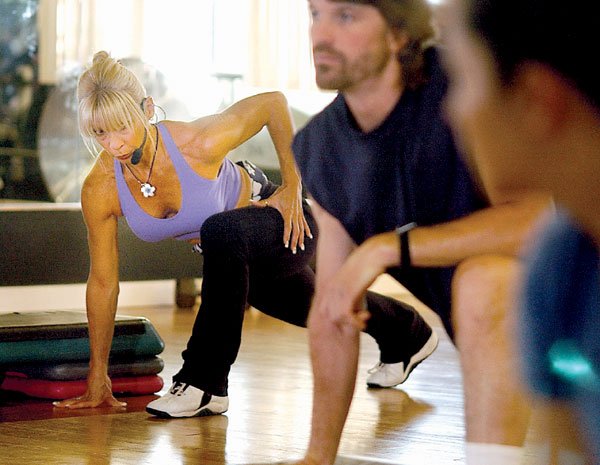By Melania Zaharopoulos
”
I lost 20 pounds and three dress sizes in just four weeks!
”
”
It’s so easy!
”
”
Shed those unwanted pounds!
”
Ads promising miracle diets, plans, drinks, patches and pills
constantly bombard Americans. Which one to choose?
By Melania Zaharopoulos
“I lost 20 pounds and three dress sizes in just four weeks!” “It’s so easy!”
“Shed those unwanted pounds!”
Ads promising miracle diets, plans, drinks, patches and pills constantly bombard Americans. Which one to choose? Atkinson’s or The Zone? Macrobiotic? The Hollywood Miracle? Or how about the nation’s latest craze, The South Beach Diet?
We all want to be healthy, don’t we?
Sort of ironic that in our national quest for beauty we’ve still managed to become the fattest nation on earth.
Perhaps it’s our chronic lack of attention to the fine print: Results not typical. Or maybe it’s all those hours in front of Must See TV.
But not to worry. The answers are all here in the South Valley Diet! We asked local health experts the same question: “What are we doing wrong?”
The answer: It all comes down to one dirty four-letter word.
Diet.
Stop Dieting
After reading this headline, several readers are likely spitting out their morning coffee. What? Don’t diet?
No, we’re not advocating that you ditch the word “no,” stock up on a flat of Ben and Jerry’s, and hibernate with your own personal gallon of nacho cheese. Calorie reduction is still an important part of losing weight, but “dieting” is a program for failure. Losing weight and leading a healthy life aren’t goals you can reach by going on a temporary plan, says Hollister dietitian Lynn Kjelson. You have to make a lifestyle shift.
“It’s not how good your intentions are, it’s the stick-to-it-ness you have,” says Kjelson, who works for Hazel Hawkins Hospital. “Life happens. Someone will get sick in the family or something happens at work. When life happens, you fall back on habits, good or bad. If it’s just a diet, it goes on the back burner. You want to make it so it’s just like brushing your teeth.”
Kjelson knows all too well about radically shifting habits. When she was 12 years old her father had to undergo open-heart surgery. Thereafter, careful attention had to be paid to his new nutritional guidelines.
“It amazed me how you could change your health by changing your diet,” says Kjelson, who credits the experience with directing her to a career.
While weight loss might be the crucible for most dieters, the effects of lifestyle changes are broader and more sustainable.
“You don’t just look better,” says Cathy Huggins, a personal trainer at Rovella’s Athletic Club in Hollister. “People usually come to me if they want to lose weight. But exercise is healthy for you emotionally and physically. It’s helped me get through some really tough things including the deaths of my parents. If I didn’t have this, I would have gone into a deep depression … The fat loss is the bonus.”
Keep It Simple
So how does this whole getting in shape thing happen?
One day you wake up, look in the mirror and realize you’re dissatisfied. This is it. This is the day you will start being healthy. No more McDonalds. No more armchair quarterbacking. You’re going to eat salad all day long, run ten miles a day and love every minute.
It can be easy to get ahead of yourself once you’ve been inspired to get healthy, but if this is your idea of a fitness plan, slow down.
“Don’t start with grand schemes that are doomed to failure,” says Gilroy acupuncturist Clare Buchanan. “Realistic goals may not have an immediate result, but the French have a saying: ‘Little by little the bird makes his nest.'”
“You’re going to be exhausted by day three if you try to go out and run five times a week after a long period of inactivity,” adds Kjelson. “You need to build up your endurance and you have to do something manageable to get there.”
Think of fitness in terms of baby steps. You can always increase the intensity of a workout. You can’t erase the damage of an injury.
Start slow, even taking just a leisurely stroll with a friend. Aim for 15 minutes of aerobic exercise a day at first and build from there. Make that stroll longer each week, and remember to increase the pace until you’re really taking a brisk walk.
Whatever you settle on for your source of exercise, find something you actually enjoy. Do you like to dance? To swim or hike? Do you prefer to work out alone, with a friend or as part of a group? These things can all be incorporated into your workout schedule.
If all else fails, chores offer some free exercise opportunities.
“We’ve gotten away from doing our own things – mowing our lawn, cleaning our house, washing our car,” says Huggins. “Even doing just one of those things is going to give you a free workout, not just save you money.”
Make Good Choices
Above all, remember to make choices for yourself before your lifestyle makes choices for you. Just because heart disease or diabetes runs in your family doesn’t mean that you have to sit back and accept it for yourself.
While inactivity, the intake of fast and processed food, socioeconomic status and single parenthood are all contributors to diseases like diabetes, you can easily change two of those factors.
“Shop on the outer isles,” says Kjelson. “That’s where all the fresh ingredients are. Add vegetables to every meal and try to get away from eating out.”
Refined white sugars and simple carbohydrates like breads and crackers are more easily turned into fat by your body than protein and vegetables. If you’re tempted to go for the mashed potatoes first, just tell yourself to save the best for last. By eating high-fiber dishes first, you’re minimizing your hunger for sugary carbs later on.
Eating a balanced diet is more about limiting quantity than quality. You can still have the things you crave, but remember to enjoy them in moderation. Look at the nutritional guides on your packaged foods, and be especially sure to note suggested portion sizes. As you become more aware of what you’re eating, you’ll be better able to make informed decisions about your health.
“By eating healthily and making an effort to keep a positive and grateful attitude, we nurture ourselves,” says Buchanan. “This is our only life – we have to take care of ourselves to have it be sacred.”
Dining out right
1. Share a meal with a friend. If you can’t split your meal with someone, cut your portion in half and box part of it before you begin eating.
2. Skip the soda. By sticking with water, you’ll be saving yourself those empty calories and all of that unnecessary refined sugar.
3. Ask your server if you can have salad instead of normal fillers like chips and dip or bread.
4. Have your meats grilled rather than fried.
5. Ask about your meal’s preparation. If you discover the sauce it comes in is butter or cream-based, ask if the cook can substitute a heart-healthy marinara instead.
6. Ask for condiments on the side. When you control the amount, you control the added fat.
7. Eat around your plate. Try eating your salad, veggies, and meat first. Then go ahead and have some carbs. If you fill up on fiber and protein, you’re less likely to consume large amounts of high-fat carbs.
8. Wait on dessert. Your body takes longer to extract nutrients from hard-to-digest sources like meat and vegetables. When you dump dessert into the mix, it jumps on the easily extracted sugars and fats, bypassing the other valuable nutrients in the meal you’ve just eaten. If you must have dessert, adults should wait at least 30 minutes. Children should not have dessert for at least one hour after a meal.
Dieting myths
Myth No. 1: I only need to cut calories.
The Truth: While cutting calories is an integral part of losing weight and beginning to live a healthier life, drastically cutting your caloric intake can actually slow down your metabolism. Cutting too many calories from your diet, especially if you are doing so by skipping meals, may actually stop you from losing weight. Eating a balanced diet low in saturated fats and refined sugars is better than going extremely low-cal.
Myth No. 2: I should try to eliminate fat from my diet.
The Truth: There are thousands of products on the market today labeled non-fat or low-fat. While reducing the number of saturated fats and trans-fats in your diet may be a good idea, cutting out fat altogether is actually bad for you. Your body’s cells depend on fats absorbed from heart-healthy sources like olive oil and fish. If you must buy pre-processed foods or microwaveable meals, remember to flip them over and check the amounts of saturated and unsaturated fats.
Myth No. 3: If a little exercise is good, a lot must be better.
The Truth: While it is good to maintain healthy habits, taking them to excess can be harmful in the long run. If you are exercising more than two hours per day you need to be sure to consume enough fluids and protein to keep your body healthy. The physical stress of aerobic exercise combined with an insufficient diet may actually speed up the aging process. And women who over-exercise may be putting their fertility at risk. If you have not gone through menopause but have stopped menstruating or are experiencing infrequent menstruation, it may be time to consult your doctor.












